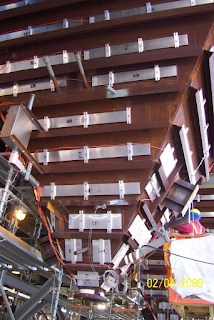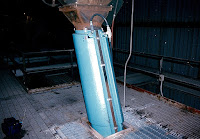A blog that provides educational information on electric heating systems used on hoppers, chutes, tanks and vessels; electric heating systems used for pre and post weld heat treating; heat treating power consoles; custom heat treating furnaces; and single & multi-operator welders. For more information, visit HotfoilEHS.com
Welding Heat Treatment Power Consoles
 |
| Welding Heat Treatment Power Consoles by Hotfoil-EHS |
Power consoles are standardly offered in 6, 9, 12, 18, and 24 zone configurations with a variety of control and recording systems. All Hotfoil-EHS power consoles are available in Stainless Steel and can be customize to your requirements.
Have a special requirement? Just ask. Need a special color, coating or controls? Hotfoil-EHS is eager to provide a custom power console to meet your exact needs.
Temperature recorders are available for applications requiring documentation and certification. Fully automatic controllers are provided when specific heat-up and cool-down profiles are needed.
EHS manufactures and sells accessories including:
Temperature recorders are available for applications requiring documentation and certification. Fully automatic controllers are provided when specific heat-up and cool-down profiles are needed.
EHS manufactures and sells accessories including:
- ceramic heaters,
- thermocouple attachment units (TAU)
- pin welders
- hardness testers
- thermocouple wire
- insulation
Eliminate Costly Hopper Pluggage with Electric Hopper Heaters
 |
| Modular, metal-clad hopper heaters installed on large hopper. |
Due to the temperature differential between the hot internal temperature of the hopper and the cooler exterior, condensation forms on the internal wall surfaces, The condensation, combined with the fly ash, creates a concrete-like material that bonds to the hopper walls. The accumulation of this material eventually clogs the hopper to the extent it cannot be emptied. At this point, the only way to free the clogged material is with sledge hammers and pneumatic tools and long periods of downtime and the related expense.
To prevent the fly ash and condensate mixture from forming,
Hopper heaters come in a variety of physical sizes, voltages, and wattages. Most often, hopper heaters come in pre-engineered sets that have been specified and configured by an applications engineer.
For more information on any hopper heating application, contact Hotfoil-EHS for a free consultation. Visit http://www.hotfoilehs.com or call 609.588.0900.
The Hotfoil-EHS Fusion 45 Induction Heating Console
Induction heating can improve your bottom line by decreasing weld failures, and decreasing setup and tear down times. The technology allows for accurate temp control, without heavy electrical service or complicated controls. The portability and ease of use will allow you to heat more welds faster.
For more information call Hotfoil-EHS at 609.588.0900 or visit http://www.hotfoilehs.com.
For more information call Hotfoil-EHS at 609.588.0900 or visit http://www.hotfoilehs.com.
Induction Heating Provides Welders Uniformity and Shortens Welding Time
Ovens are great for uniformity and control, but require transport and time. They're certainly not convenient.
A great alternative, one that provides excellent uniformity, control, and convenience, is induction heating.
Induction heating is unique because it uses molecular excitation as its source of heat, as opposed to open flames or external electric elements.
Induction heating works very quickly, and since there is no contact with the target piece, there are far less concerns about part contamination. Many industrial processes use induction heating when very high temperatures and uniform control is desired.
Its important to note that the heat is created from inside the object itself, with no open flame or external electric heat source.
Induction heating is used to heat conductive materials. Developed in the early 20th century, it quickly became a popular choice for hardening military equipment parts during wartime. Because of induction heating’s controllability, speed and consistent output, its popularity continued to grow as new manufacturing and production methodologies were developed. Today, induction heating has become a popular technology for the welding industry to provide pre and post-weld stress relief.
Induction heaters provide temperatures and cycle times hard to achieve otherwise. By virtue of their high temperature capabilities, very fast heat up times, precise application of heat, excellent controllability, and ease of setup / breakdown, the use of induction heating has been know to cut 30% to 50% of total weld cycle time in real-life welding applications.
Induction heaters consist of a few primary components: An electromagnet and an electronic oscillator that passes a high-frequency alternating current (AC) through the electromagnet. RF (radio frequency) energy is transferred into the workpiece via electromagnetic waves. These alternating magnetic waves penetrate the object, creating electric eddy currents. These eddy currents (Foucault currents) flow through the target piece and produce heat.
Pre and post-weld heat treating (stress relieving) is a growing market for induction heating systems because it offers significant benefits such as excellent heat placement and distribution, lower cycle times, safety, ease of use, and efficiency.
For more information about induction heaters for pre and post-weld heat treating visit HotfoilEHS at http://www.hotfoilehs.com or call 609.588.0900.
Don't Let Frozen Aggregate Clog Your Process Equipment
 |
| FRP hopper heaters |
 |
| FRP chute heater |
 |
| FRP trough heater |
 |
| FRP trough heater |
Custom Control Panel Fabrication: Start to Finish
Hotfoil-EHS provides custom control panels for a variety of applications. Know for their quality, service, and availability, Hotfoil's experience in designing systems is broad.
Hotfoil-EHS has traditionally focussed on electric heating systems including heating tanks and vessels as well as electric heat tracing, but more recently has developed an expertise in combustion heating system controls. For more information visit http://www.hotfoilehs.com or call 609-588-0900.
Below is a time lapse video of a custom design control panel being fabricated from start to finish.
Hotfoil-EHS has traditionally focussed on electric heating systems including heating tanks and vessels as well as electric heat tracing, but more recently has developed an expertise in combustion heating system controls. For more information visit http://www.hotfoilehs.com or call 609-588-0900.
Below is a time lapse video of a custom design control panel being fabricated from start to finish.
Subscribe to:
Comments (Atom)


